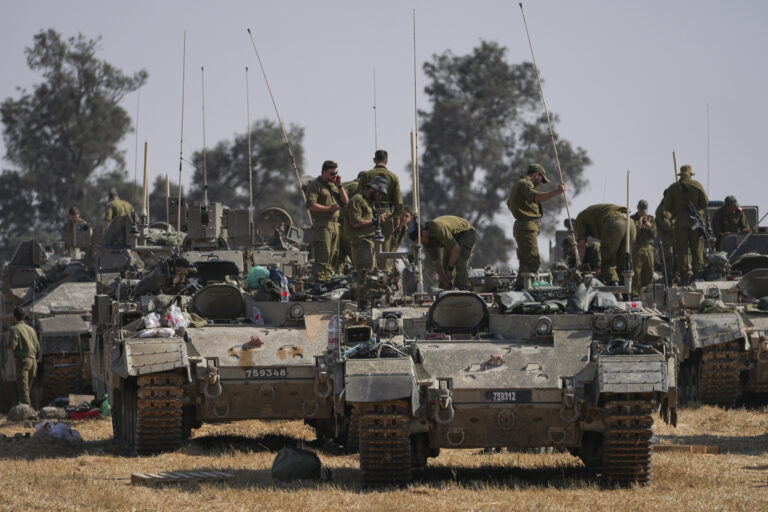While Kyiv is keeping silent about the start of any counteroffensive, fighting is raging in several sections of the front line, signaling that the long-expected campaign could be getting underway.
A video, released over the weekend by Ukraine, shows several of its soldiers in full combat gear raising a finger to their lips. “Plans love silence. There will be no start announcement,” say the words flashing on the screen afterward, followed by warplanes in flight.
Moscow claims it successfully fended off a Ukrainian attempt to ram through Russia’s defenses, but some pro-Kremlin military bloggers paint a different picture, acknowledging that Kyiv’s troops made some quick gains.
‘SHAPING OPERATIONS’
In recent weeks, Ukraine has intensified the shelling of Russian positions and successfully pushed back against Russia’s attempts to extend its gains outside the eastern city of Bakhmut that it reclaimed last month in the war’s longest and bloodiest battle.
Pro-Kyiv paramilitary groups of Russians who have been fighting alongside Ukrainian armed forces also launched forays over the border into Russian territory, attacking the Belgorod region.
The Ukrainian shelling and the cross-border incursions ravaged several towns and villages near the frontier and forced the evacuation of thousands of residents, angering Russian hawks who criticized the Kremlin for failing to strike back resolutely.
And on May 30, a rare drone attack targeted Moscow, causing only minor damage but exposing glaring breaches in the capital’s air defenses and underlining its vulnerability.
Military analysts describe the attacks as part of “shaping operations,” a series of moves intended to probe Russian defenses, force Moscow to spread its forces thin and draw attention from areas where Ukraine might focus its counteroffensive.
The Russian military, in turn, has intensified strikes deep inside Ukraine, launching a barrage of near-daily drone and missile attacks against high-value military facilities.
Russia declared it destroyed the U.S.-made Patriot missile defense systems in Kyiv, successfully struck the military intelligence headquarters, also in the Ukrainian capital, and hit air bases and weapons stockpiles in several regions. These claims couldn’t be independently verified. Ukrainian officials acknowledged some of the strikes but have remained cryptic about the damage.
Russian military bloggers described them as part of Moscow’s efforts to derail the counteroffensive by softening Ukraine’s air defenses and destroying Western weapons and ammunition intended for the campaign.
In Washington, a U.S. official speaking on condition of anonymity to discuss sensitive matters, said: “We have no reason to believe any Russian action has had any spoiling effect on pending or ongoing Ukraine operations.”
HYBRID WARFARE
Both sides have sought to mislead and weaken each other through propaganda and disinformation.
On Sunday, Ukraine hacked into some TV broadcasts in Crimea to air a menacing Ukrainian military statement about the counteroffensive.
In an unprecedented move intended to undermine morale, broadcasts in several Russian regions were hacked Monday to carry a fake address by President Vladimir Putin in which a voice resembling his was heard declaring martial law, a nationwide mobilization and a massive evacuation of three border regions.
Kyiv, in turn, accused Moscow of hybrid warfare. It said Russian claims of a major Ukrainian attempt to pierce Russian defenses was part of “information and psychological operations” intended to “demoralize Ukrainians and mislead the community.”
Ukrainian presidential adviser Mykhailo Podolyak mocked the Russian claims as “virtual reality,” saying sardonically: “Moscow is already actively involved in repelling … a global offensive that does not yet exist.”
THE MAIN STRIKE
Military analysts say Ukraine has tried to hide its intentions by launching multiple attacks on several sectors of the front line to force Russia to scatter its resources and distract them from where the main strike would be launched.
“The attacks in the Zaporizhzhia and the Donetsk regions, the developments in Russia’s Belgorod region, and increasingly frequent strikes on Russian military depots in the rear are all part of preparations to the Ukrainian counteroffensive,” said Ukrainian military analyst Roman Svitan. “Kyiv is looking for Russia’s weak spots and trying to spread the front as wider as possible.”
Many military experts expect Ukraine to try to ram through Russian defenses toward the Sea of Azov coast to break the land corridor to Crimea that Moscow created after capturing the key port of Mariupol in May 2022.
Russian officials and military bloggers suggested the latest attacks in the southern part of the Donetsk region and the neighboring Zaporizhzhia region that began Sunday could herald the start of that big push.
The Russian Defense Ministry said Ukraine on Sunday sent several battalions to try to ram through the Russian defensive positions, which were pushed back after suffering significant losses.
Some Russian military bloggers offered a less-optimistic view, saying Ukrainian troops managed to make some gains Sunday and were pouring more resources to exploit that success. Some said that, for the first time, German-made Leopard tanks were seen in significant numbers in the area.
TASKS AND CHALLENGES
Whether or not the latest fighting marks the start of Ukraine’s counteroffensive, many observers warned against expectations of a quick breakthrough that could end the war quickly.
“We need to understand that what we’re calling the Ukraine counteroffensive is not like a football match,” said General Sir Richard Barrons, the former Commander of the U.K. Joint Forces Command. “You know, it’s not going to be done and dusted in 90 minutes with a halftime on an appointed day. It’s been nine months at least in the preparation in the sense that they’ve had to gather weapons and ammunition from NATO. Not enough, I think, so far.”
Barrons, who is co-chair of the consulting group Universal Defence & Security Solutions, noted Russia has bolstered its forces, replenished some of its ammunition stockpiles and built complex defensive lines.
“Russia has had time to lay out a textbook fixed defense,” he said, with three lines of trenches and held-down positions allowing tanks to come forward to fire at the attackers.
“They will have rehearsed the artillery fire plan in support of defending those lines, and they will have rehearsed the crucial rapid counterattacks, which are so vital when you are trying to restore a line that’s being attacked,” Barrons added.
He predicted Ukraine will try to focus its nine newly formed brigades armed with Western weapons to ram through Russian defenses in just one, two or three places, trying to concentrate their forces to have a significant numerical superiority “in order to smash their way through and then exploit and hold on to the ground that they’ve taken.”
The offensive “is going to be, in a land sense, quite a narrow frontage,” he said.
“I’d be surprised if it’s more than 20 miles, to be honest,” Barrons added. “The battlefield success has to be enough to show hope and prospect to bind in further strategic support.”
He emphasized the Russian army has learned from its setbacks last fall when it retreated from large areas in the Kharkiv and Kherson regions under the brunt of a Ukrainian counteroffensive, noting it could be more challenging this time for Ukraine to push the Russians out.
“The thing that is most important about this offensive is whenever it comes, however successful it is, it is simply not possible for it to throw every Russian out of Ukraine unless the Russians decided to give up and go,” Barrons said. “And they are not going to do that.”
The West must mobilize its military industries to ramp up support for Ukraine to allow it to win, he said.
“The key to this counteroffensive is to show enough battlefield success to show to the West that the right and reasonable thing to do is to get on with industrial mobilization,” Barrons said, estimating that Europe must spend about 100 billion euros ($107 billion) a year for the next three years.
(AP)











